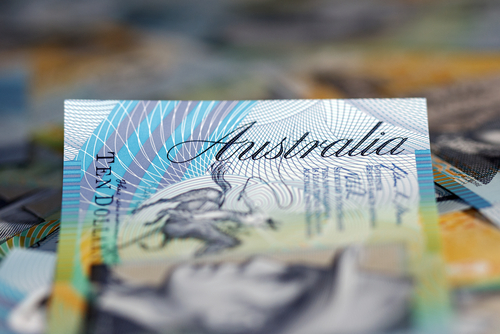The latest GDP growth figures for the Australian economy, missed the news agency forecasts, causing a sudden sell off in the Aussie dollar versus its peers, during the Sydney and Asian trading sessions. Reuters had forecast a 0.5% rise for Q4 2018, the figure came in at 0.2%, whilst annually the year on year growth fell to 2.3% from 2.7%. The cause of the fall in GDP, was pointed towards the slowdown in China’s economic activity, which is undoubtedly Australia’s major export destination for its minerals; Australia’s economic growth over recent decades, has relied heavily on delivering minerals, such as iron ore and coal, to China.
In 2017-18, China was by far Australia’s largest trading partner, contributing $194.6 billion worth of imports and exports. This was in excess of the combined value of trade with Japan and the United States ($147.8 billion). Iron ore and coal are Australia’s key exports, together they are worth more than $120 billion a year, or 30% of sales to foreign countries.
At 9:00am U.K. time, AUD/USD traded at 0.702, down -0.77% on the day, having breached S3, the major pair is now down circa -10% yearly. A similar price action pattern was repeated with many Aussie dollar peers; AUD/JPY traded down -0.81%, at 78.65, crashing through S3. Both currency pairs are significantly below the 200 DMAs. As safe haven currencies, the value of JPY and USD versus AUD, is an indication of the current lack of sentiment surrounding AUD. In a negatively correlated trade, the fall in the value of the Aussie dollar benefited the key market indices in Australia; ASX 200 closed up 0.75% on the day, up circa 10.6% yearly.
Theresa May, the U.K. prime minister, is once again off to Brussels, on one of her shuttle diplomacy missions. After her attorney general made no progress earlier in the week, trying to install legalise speech into the withdrawal agreement to fool MPs, analysts and political journalists, are scratching their heads regarding what she expects to achieve at this late stage. The next vote on the WA is set for March 12th and the U.K. is currently set to crash out, with no agreement in place, on March 29th.
Sterling is (so far) holding up versus its peers. However, Tuesday’s nervous price action, as pairs such as GBP/USD and EUR/GBP whipsawed in wide ranges, oscillating between bearish and bullish tendencies, should serve as a warning regarding just how reactive the FX markets could be to any Brexit breaking news, whether positive or negative for the U.K.’s future. At 10:00 am U.K. time, GBP/USD traded in a tight range with a bearish bias, at 1.314 close to the daily pivot point, down -0.21% on the day and down -1.23% weekly. EUR/GBP traded up 0.12%, reclaiming the 0.8600 handle. The U.K. FTSE 100 traded up 0.11%.
EUR/USD traded close to flat at 1.130, whilst the majority of euro pairs made positive gains, during the Asian and London-European trading sessions. EUR/AUD rose sharply, whilst the euro also made gains versus other commodity currencies, such as NZD and CAD. Eurozone market indices fell during the first part of the morning’s trading session; at 10:15am Germany’s DAX traded down -0.23% and France’s CAC down -0.14%. The only E.Z. economic calendar news of note published on Wednesday morning, concerned Germany’s construction PMI; recording a 54.7 reading for February, rising from 50.7 in January.
Investors and FX traders are beginning to switch their focus to the euro and the main European indices, as the ECB’s rate setting announcement appears on their radar screens. The general consensus is that the rate will remain at 0.00% when broadcast at 12:45pm U.K. time on Thursday. But it’s the press conference, held by Mario Draghi forty five minutes later in Frankfurt, that has the capacity to move the market in the euro.
During Wednesday afternoon and evening, there’s two high impact calendar events which FX traders need to carefully monitor. The first involves Canada’s central bank, the BOC, announcing their latest rate setting decision. At 1.75%, the consensus opinion, derived after news agencies such as Bloomberg and Reuters have polled their panel of economists, is for no change. Naturally analysts and FX traders will also look towards any policy statement accompanying the decision, for any signs that the BOC is altering its monetary policy, to a more dovish stance. USD/CAD traded at 1.334 at 10:30am, up 0.25%, having breached R1.
The second high impact event, involves the publication of the USA Fed’s Beige Book at 19:00pm U.K. time, known formally as the “Summary of Commentary on Current Economic Conditions by Federal Reserve District”. The Fed’s description is; “a report is published eight times per year. Each Federal Reserve Bank gathers anecdotal information on current economic conditions in its District, through reports from Bank and Branch directors and interviews with key business contacts, economists, market experts, and other sources. The Beige Book summarises this information by District and sector. An overall summary of the twelve district reports is prepared by a designated Federal Reserve Bank on a rotating basis.”
The publication can move the markets for the U.S. dollar and market indices, dependent on its content. It could be regarded as an adjunct to the monetary policy outlined most recently by the Fed chair Jerome Powell, and any forward guidance the FOMC and Fed might have provided.


